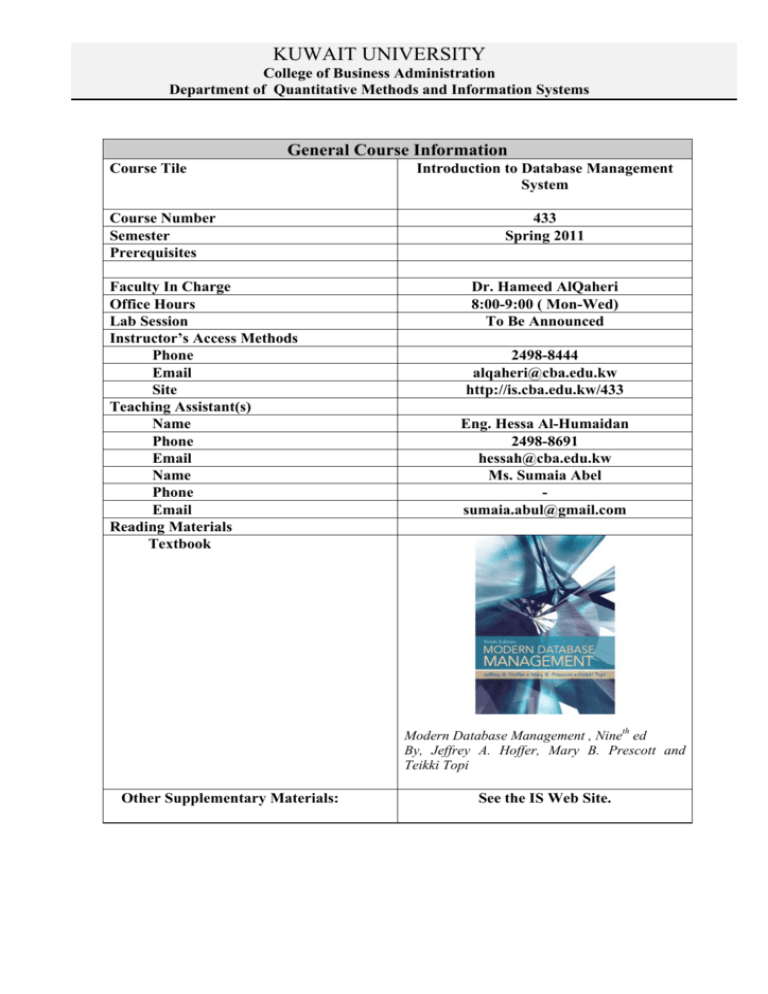Information Systems @ Kuwait University
advertisement

KUWAIT UNIVERSITY College of Business Administration Department of Quantitative Methods and Information Systems General Course Information Course Tile Course Number Semester Prerequisites Faculty In Charge Office Hours Lab Session Instructor’s Access Methods Phone Email Site Teaching Assistant(s) Name Phone Email Name Phone Email Reading Materials Textbook Introduction to Database Management System 433 Spring 2011 Dr. Hameed AlQaheri 8:00-9:00 ( Mon-Wed) To Be Announced 2498-8444 alqaheri@cba.edu.kw http://is.cba.edu.kw/433 Eng. Hessa Al-Humaidan 2498-8691 hessah@cba.edu.kw Ms. Sumaia Abel sumaia.abul@gmail.com Modern Database Management , Nineth ed By, Jeffrey A. Hoffer, Mary B. Prescott and Teikki Topi Other Supplementary Materials: See the IS Web Site. KUWAIT UNIVERSITY College of Business Administration Department of Quantitative Methods and Information Systems Course Description The course introduces students to the basic theoretical and fundamental concepts, constructs, techniques related to the database application Development required for an information system within a business environment. The course is organized into Five Parts. Part 1 presents the basic concepts of Database Management System. Parts 2, 3 and 4 covers the three phases of database application development namely the analysis, design and implementation. In the Analysis phase techniques for requirements collections and structuring using a conceptual model such as E-R model or UML is discussed. In design phase techniques and rules for converting the output of the analysis phase for producing a normalized model are discussed. In the implementation phase various tools and techniques (such as SQL, MS Access and VB) for implementing the normalized model are discussed. Course Objectives 1. Familiarize the students with the basic and fundamental theoretical concepts, constructs and techniques on DBMS. 2. Enable the students to get sufficient hand-on experience allowing them to applying the theory and techniques learned to real life problems using a popular DBMS environment such as MS ACCESS These two objectives are fulfilled though class discussion, pencil exercises, implementation of some of real life problems and implementation of a sizable project. Student Evaluation Methods A combination of assessment methods will be used to ensure that course objectives are fulfilled and the required course exist characteristics and skills are attainment. Assignments Project 10% 10% of the final " Exams Two Midterms (equal weight) Final 40% 40% " " Important Dates: First Midterm Date Second Mid Term Date March 30 , 2011 May 4, 2011 KUWAIT UNIVERSITY College of Business Administration Department of Quantitative Methods and Information Systems Grade Distribution Kuwait University Bylaws set the following Total Percentage scale for the assignment of grades. A AB+ B BC+ C CD+ D F >= 95 90-94 87-89 83-86 80-82 77-79 73-76 70-72 65-69 60-64 <=59 KUWAIT UNIVERSITY College of Business Administration Department of Quantitative Methods and Information Systems COURSE CONTENT I. Part 1: Overview of DBMS Concepts, Construct and Issues Chap. 1 The Database Environment • • • • • • Basic concepts and Definitions Traditional File Processing Systems The Database Approach The Range of Database Applications Advantages of Database Applications Components of the Database Environment Chap. 2 Database Development Process • • • • • II. Database Development Within Information System Development Database Development Process Managing the People Involved in the Database Development Three-Schema Architecture for Database Development Three-Tiered Database Location Architecture Part II: Database Application Analysis Chap. 3 Modeling Data in the Organization • • • The E-R Model Entity-Relationship Model Constructs Relationships Chap. 4. Enhanced E-R Model and Business Rules • • • • • Representing Supertypes and Subtypes Specifying Constraints in Supertype/Subtype Relationships Business Rules: An Overview Business Rules: defining Structural Constraints Business Rules: defining Operational Constraints KUWAIT UNIVERSITY College of Business Administration Department of Quantitative Methods and Information Systems III. Part III: Database Application Design Chap. 5 Logical Database Design and the Relational Model • • • • • • • IV. The Relational Data Model Integrity Constraints Transforming EER Diagrams into Relations Introduction to Normalization The Basic Normal Forms ( First, Second and Third) Merging Relations Advanced Normal Forms ( Byce-Codd, and Forth Normal Form) NOTE: LOOK at Appendix B pages 691-696 PART IV: Database Application Implementation Chap. 7 Introduction to SQL • • • • • • • • • • • The Role of SQL in a Database Architecture The SQL Environment Defining A Database in SQL Inserting, Updating, And Deleting Data Internal Schema Definition in RDBMs Processing Single Tables Processing Multiple Tables View Definitions Ensuring Transaction Integrity Data Dictionary facility Triggers and Procedures Chap. 8 Advanced SQL • Processing Multiple Tables • Ensuring Transaction Integrity • SQL:200N Enhancement and Extensions • Embedded SQL and Dynamic SQL • OLAP SQL V. PART V: Other Issues • Data and Database Administration • • • Client/Server Database Environement Internet Database Environment Data Warehousing









